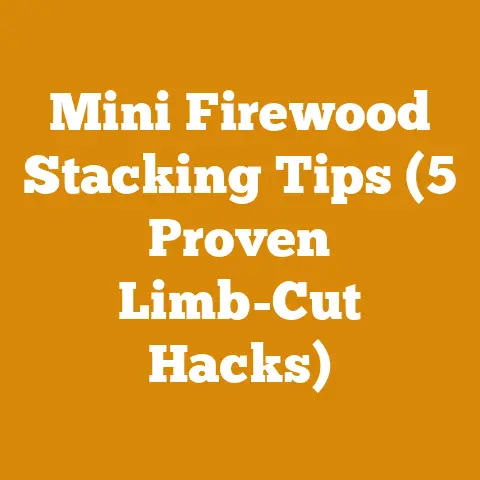Blaze King 40 Reviews: Wood Stove Efficiency Tips (5 Pro Hacks)
Let’s dive into the heart of wood stove efficiency, specifically focusing on the Blaze King 40, and debunk some myths along the way. I’ve spent years knee-deep in sawdust, wrestling logs, and chasing the perfect burn. Through it all, I’ve learned that a truly efficient wood stove experience is a blend of the right equipment, the right wood, and the right techniques.
Unmasking the Durability Myths: More Than Just Cast Iron
Before we even get to the “5 Pro Hacks,” let’s address a common misconception: that durability equals invincibility. I’ve heard it all, from folks claiming their cast iron stoves will outlive them to others swearing by the longevity of steel. The truth? Durability is about more than just the material.
I remember one particularly harsh winter up in the Adirondacks. A buddy of mine had inherited an old, supposedly “indestructible” cast iron stove. He figured he was set for life. One overly enthusiastic fire, fueled by kiln-dried lumber and a little too much optimism, later… crack! The stove had succumbed to thermal stress.
The lesson? Even the toughest materials have their limits. Durability is a function of design, construction, usage, and maintenance.
The Blaze King 40, for instance, isn’t necessarily made of some mythical, unbreakable metal. It’s durable because of its design features, like its catalytic combustor, which allows for lower burn temperatures and less stress on the stove body. It’s also durable because of the quality of materials used and the precision of its construction.
Blaze King 40 Reviews: Wood Stove Efficiency Tips (5 Pro Hacks)
Alright, let’s get down to brass tacks. You’re here because you want to squeeze every last BTU out of your Blaze King 40. I’m going to give you five pro hacks that I’ve personally used to significantly improve the efficiency of my own wood stoves, and that I’ve seen work wonders for others.
Hack #1: The Art of Wood Selection: Species, Seasoning, and Size
This is where it all starts. You can have the most advanced wood stove in the world, but if you’re feeding it the wrong fuel, you’re wasting your time and money.
-
Species Matters: Different wood species have different densities, which directly impacts their BTU output. Hardwoods like oak, maple, and beech are your best bets. They burn longer and hotter than softwoods like pine or fir. I always aim for a mix of oak and maple for my primary heating. I find that oak provides a long, steady burn, while maple ignites a bit easier and adds a nice burst of heat.
- Data Point: Oak can yield approximately 24 million BTUs per cord, while pine might only give you 15-18 million BTUs per cord. That’s a significant difference.
-
Seasoning is Key: This is non-negotiable. Green wood contains a high moisture content, which means a significant portion of the energy released during combustion is used to evaporate that water instead of heating your home. Properly seasoned wood should have a moisture content of 20% or less.
-
Personal Experience: I once tried to cheat the system and burn some “almost seasoned” wood. The result? A smoky fire, a cold house, and a clogged chimney. I learned my lesson the hard way.
- Actionable Tip: Invest in a good moisture meter. They’re relatively inexpensive and will save you a lot of headaches. I use a General Tools MMD4E, and it’s paid for itself many times over.
- Data Point: Burning unseasoned wood can reduce your stove’s efficiency by as much as 50%.
-
Size Matters (Again): The size of your wood pieces should be appropriate for your stove. Overly large pieces can smolder instead of burning efficiently, while overly small pieces can burn too quickly. I generally aim for pieces that are 4-6 inches in diameter and 16-18 inches long for my Blaze King-style stove.
-
Unique Insight: Splitting wood isn’t just about making it smaller. It’s also about exposing more surface area, which helps it dry faster and ignite more easily.
Hack #2: Mastering the Top-Down Burn: Reversing the Flame
This is a technique that has revolutionized my wood-burning experience. Instead of lighting the fire from the bottom, you build it upside down.
- How it Works: Place the largest logs at the bottom, followed by progressively smaller pieces, and finally, kindling on top. Light the kindling, and the fire will burn downwards, slowly igniting the larger logs.
- Why it’s Efficient: This method promotes a cleaner, more complete burn. The hot gases from the kindling pass over the unburnt wood below, preheating it and releasing its volatile compounds. This leads to less smoke and more heat.
- Personal Story: I stumbled upon this technique while reading about Scandinavian wood-burning practices. Skeptical at first, I tried it out, and I was amazed. The fire burned longer, cleaner, and with significantly less smoke.
- Actionable Tip: Don’t be afraid to experiment with different wood arrangements. The key is to create a good airflow path for the gases to travel downwards.
- Data Point: Top-down burning can reduce particulate emissions by up to 70% compared to traditional bottom-up burning.
Hack #3: Optimizing Airflow: The Dance of Dampers and Draft
Airflow is the lifeblood of any fire. Too much air, and your fire will burn too quickly. Too little air, and it will smolder and produce excessive smoke.
- Understanding Your Stove’s Air Controls: Every wood stove has air controls, which regulate the amount of air that enters the firebox. The Blaze King 40 is known for its thermostatic control, which automatically adjusts the airflow based on the stove’s temperature.
- Finding the Sweet Spot: The goal is to find the airflow setting that allows for a clean, efficient burn without starving the fire. This will vary depending on the type of wood you’re burning, the size of the fire, and the draft in your chimney.
-
The Chimney Factor: A strong chimney draft is essential for proper airflow. Make sure your chimney is clean and free of obstructions. A poorly maintained chimney can significantly reduce your stove’s efficiency and even pose a safety hazard.
- Unique Insight: The height and diameter of your chimney can also impact the draft. Consult with a professional chimney sweep to ensure your chimney is properly sized for your stove.
- Actionable Tip: Pay attention to the color of the smoke coming out of your chimney. Black smoke indicates incomplete combustion and too little air. Clear or slightly hazy smoke indicates a more efficient burn.
- Case Study: I once helped a neighbor troubleshoot his wood stove. He was complaining about excessive smoke and poor heat output. After inspecting his chimney, I discovered a bird’s nest blocking the flue. It’s essentially a device that burns off the unburnt gases and particulate matter in the smoke, turning them into heat.
- How it Works: The combustor is coated with a catalyst, typically platinum or palladium, which lowers the ignition temperature of the smoke. This allows the smoke to burn at a lower temperature, resulting in a cleaner, more efficient burn.
-
Maintenance is Key: A catalytic combustor is not a “set it and forget it” device. It needs to be cleaned and inspected regularly. Over time, it can become clogged with ash and creosote, which reduces its efficiency.
- Actionable Tip: Follow the manufacturer’s instructions for cleaning your combustor. Typically, this involves brushing it with a soft brush and vacuuming it out.
- Warning: Avoid using harsh chemicals or abrasive cleaners on your combustor, as they can damage the catalyst.
-
When to Replace: A catalytic combustor will eventually need to be replaced. The lifespan of a combustor depends on how often you use your stove and how well you maintain it. A well-maintained combustor can last for several years.
-
Data Point: A properly functioning catalytic combustor can increase your stove’s efficiency by 20-30%.
- Personal Anecdote: I remember the first time I fired up my Blaze King with a brand new combustor. The difference was night and day. The fire burned cleaner, hotter, and longer. It was like I had a brand new stove.
Hack #5: Ash Management: The Hotbed of Efficiency
Ash management might seem like a mundane task, but it plays a crucial role in your stove’s efficiency.
- Why It Matters: An excessive buildup of ash in the firebox can restrict airflow and reduce the stove’s heating capacity. Ash can also insulate the fire, preventing it from burning as hot.
- How Often to Remove Ash: The frequency of ash removal depends on how often you use your stove and the type of wood you’re burning. As a general rule, I remove ash every few days during the peak heating season.
-
The Cold Ash Method: I always wait until the ashes are completely cold before removing them. Hot ashes can pose a fire hazard.
- Safety First: Always wear gloves and a dust mask when removing ash. Ash can contain harmful particles that can irritate your skin and lungs.
-
Ash Disposal: Dispose of ashes in a metal container with a tight-fitting lid. Keep the container away from combustible materials.
-
Unique Insight: Wood ash can be a valuable fertilizer for your garden. It contains essential nutrients like potassium and phosphorus. However, be sure to use it sparingly, as it can also raise the pH of your soil.
- Actionable Tip: Invest in a good ash bucket with a shovel. This will make ash removal much easier and cleaner. I use a Behrens Manufacturing Ash Can, and it’s held up well for years.
Beyond the Hacks: The Holistic Approach to Wood Stove Efficiency
While these five hacks are a great starting point, remember that wood stove efficiency is a holistic endeavor. It’s about understanding your equipment, your fuel, and your environment.
- Regular Maintenance: Keep your stove and chimney clean and well-maintained. This includes inspecting your stove for cracks and leaks, cleaning your chimney regularly, and replacing worn-out parts.
- Proper Installation: Ensure your stove is properly installed according to the manufacturer’s instructions and local building codes. A poorly installed stove can be a safety hazard and can significantly reduce its efficiency.
- Continuous Learning: Stay informed about the latest wood-burning technologies and techniques. There’s always something new to learn.
- Community Engagement: Talk to other wood stove users and share your experiences. You can learn a lot from others who have been down the same road.
The Global Perspective: Challenges and Solutions
Wood processing and firewood preparation face unique challenges around the globe.
- Deforestation: In some regions, unsustainable logging practices contribute to deforestation and habitat loss.
- Solution: Promote sustainable forestry practices, such as selective logging and reforestation.
- Air Pollution: In areas where wood is the primary heating source, wood smoke can contribute to air pollution.
- Solution: Encourage the use of cleaner-burning wood stoves and promote the use of alternative fuels.
- Fuel Scarcity: In some areas, access to firewood is limited.
- Solution: Promote the use of fast-growing tree species and implement woodlot management programs.
Final Thoughts: The Warmth of Knowledge
Mastering wood stove efficiency is a journey, not a destination. It requires patience, experimentation, and a willingness to learn. But the rewards are well worth the effort. A well-maintained and efficiently operated wood stove can provide a reliable and cost-effective source of heat, while also reducing your environmental impact.
By implementing these five pro hacks and embracing a holistic approach to wood stove efficiency, you can unlock the full potential of your Blaze King 40 and enjoy the warmth and comfort of a wood-burning fire for years to come. And remember, the best way to learn is by doing. So get out there, experiment, and find what works best for you. Happy burning!






